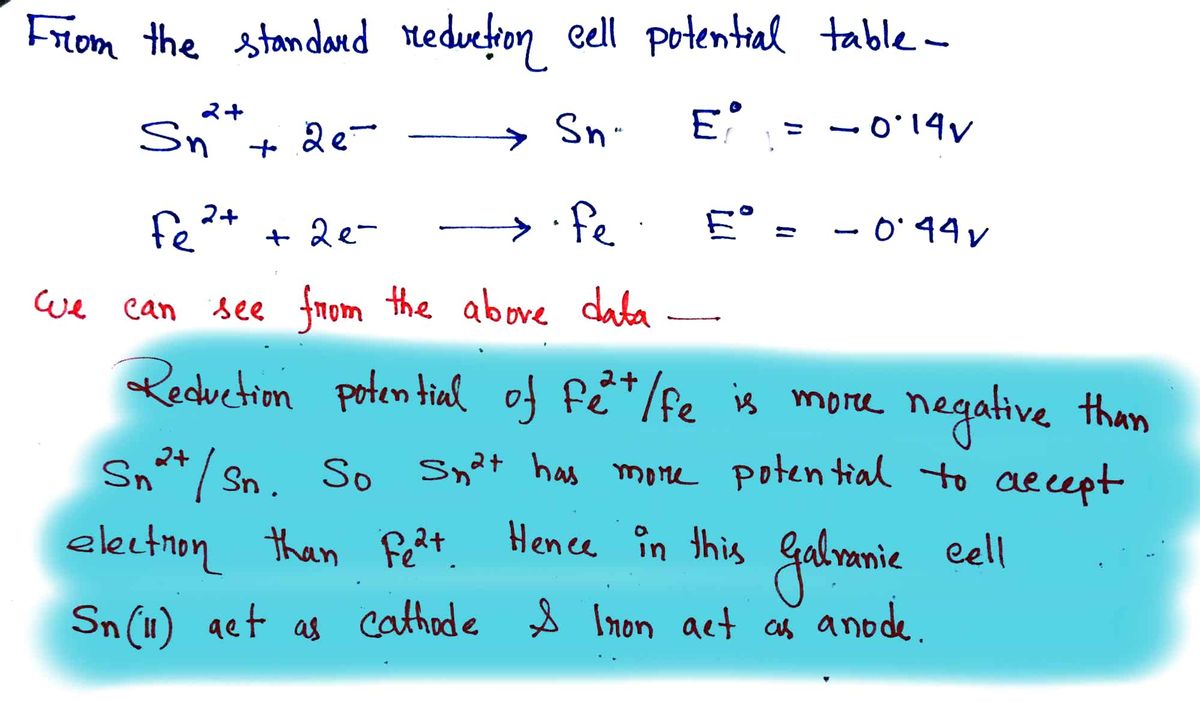( Consider a galvanic cell involving tin(II) and iron (II) and the corresponding Sn and Fe electrodes (use the data in Table 12.1 from the text). Hand draw this galvanic cell include the details below. Select the tickbox when you have completed this question. a) Draw a sketch of the cell b) Clearly identify the anode and cathode c) Write the balanced overall reaction "1
( Consider a galvanic cell involving tin(II) and iron (II) and the corresponding Sn and Fe electrodes (use the data in Table 12.1 from the text). Hand draw this galvanic cell include the details below. Select the tickbox when you have completed this question. a) Draw a sketch of the cell b) Clearly identify the anode and cathode c) Write the balanced overall reaction "1
Chemistry
10th Edition
ISBN:9781305957404
Author:Steven S. Zumdahl, Susan A. Zumdahl, Donald J. DeCoste
Publisher:Steven S. Zumdahl, Susan A. Zumdahl, Donald J. DeCoste
Chapter1: Chemical Foundations
Section: Chapter Questions
Problem 1RQ: Define and explain the differences between the following terms. a. law and theory b. theory and...
Related questions
Question
please answer a b c

Transcribed Image Text:( Consider a galvanic cell involving tin(II) and iron (II) and the corresponding
Sn and Fe electrodes (use the data in Table 12.1 from the text). Hand draw this
galvanic cell include the details below. Select the tickbox when you have completed
this question.
a) Draw a sketch of the cell
b) Clearly identify the anode and cathode
c) Write the balanced overall reaction
d) Which electrode will lose mass
e) Outline the direction of the electron flow

Transcribed Image Text:TABLE 12.1 Standard reduction potentials E* at 25 °C
Half-reaction
Strongest F₂(g) + 2e-
oxidising
agent
(oxidant)
S₂O² (aq) + 2e-
PbO₂ (s) + HSO4 (aq) + 3H+(aq) + 2e-
2HOCl(aq) + 2H+(aq) + 2e¯
MnO4 (aq) + 8H+ (aq) + 5e-
BrO3(aq) + 6H+(aq) + 6e-
PbO₂ (s) + 4H+ (aq) + 2e-
CIO3(aq) + 6H+(aq) + 6e¯
Au³+ (aq) + 3e-
CIO4 (aq) + 8H++ 8e-
Cl₂(g) + 2e-
O₂(g) + 4H+(aq) + 4e¯
Br₂(aq) + 2e-
NO3(aq) + 4H+(aq) + 3e¯
Ag+ (aq) + e-
Fe³+ (aq) + e-
1₂(s) + 2e-
NiO₂ (s) + 2H₂O(l) + 2e-
Cu²+ (aq) + 2e-
Cl₂(aq) + 40H-(aq)
Hg₂Cl₂(s) + 2e-
AgCl(s) + e-
SO2-(aq) + 4H+ (aq) + 2e-
Sn4+(aq) + 2e-
AgBr(s) + e-
2H+(aq) + 2e-
Sn²+(aq) + 2e-
Ni²+ (aq) + 2e-
Co²+ (aq) + 2e-
PbSO4(s) + H+(aq) + 2e¯
Cd²+(aq) + 2e-
Fe²+ (aq) + 2e-
Cr³+ (aq) + 3e-
Zn²+ (aq) + 2e-
2H₂O(1) + 2e-
Al³+ (aq) + 3e-
Mg²+ (aq) + 2e-
Na+ (aq) + e-
Weakest
Ca²+ (aq) + 2e
oxidising
K+ (aq) + e-
agent
(oxidant) Lit(aq) + e¯
12 12
12 12 12 12 12 12 12
2F -(aq)
2SO²-(aq)
PbSO4(s) + 2H₂O(1)
Cl₂(g) + 2H₂O(1)
Mn²+ (aq) + 4H₂O(1)
Br-(aq) + 3H₂O(1)
Pb²+ (aq) + 2H₂O(1)
Cl(aq) + 3H₂O(1)
Au(s)
CI -(aq) + 4H₂O
2Cl(aq)
2H₂O(1)
2Br (aq)
NO(g) + 2H₂O(1)
Ag(s)
Fe²+ (aq)
21-(aq)
Ni(OH)₂(s) + 2OH-(aq)
Cu(s)
2OCI-(aq) + 2H₂O(l) + 2e-
2Hg(1) + 2Cl(aq)
Ag(s) + CI-(aq)
H₂SO3(aq) + H₂O(1)
Sn²+ (aq)
Ag(s) + Br−(aq)
H₂(g)
Sn(s)
Ni(s)
Co(s)
Pb(s) + HSO4 (aq)
Cd(s)
Fe(s)
Cr(s)
Zn(s)
H₂(g) + 2OH-(aq)
Al(s)
Mg(s)
Na(s)
Ca(s)
K(s)
Li(s)
E* (volts)
+2.87
+2.01
+1.69
+1.63
+1.51
+1.47
+1.46
+1.45
+1.42
+1.38
+1.36
+1.23
+1.07
+0.96
+0.80
+0.77
+0.54
+0.49
+0.34
+0.32
+0.27
+0.23
+0.17
+0.15
+0.07
0
-0.14
-0.25
-0.28
-0.36
-0.40
-0.44
-0.74
-0.76
-0.83
-1.66
-2.37
-2.71
-2.76
-2.92
-3.05
Weakest
reducing
agent
(reductant)
Strongest
reducing
agent
(reductant)
Expert Solution
Step 1

Step by step
Solved in 2 steps with 2 images

Knowledge Booster
Learn more about
Need a deep-dive on the concept behind this application? Look no further. Learn more about this topic, chemistry and related others by exploring similar questions and additional content below.Recommended textbooks for you

Chemistry
Chemistry
ISBN:
9781305957404
Author:
Steven S. Zumdahl, Susan A. Zumdahl, Donald J. DeCoste
Publisher:
Cengage Learning

Chemistry
Chemistry
ISBN:
9781259911156
Author:
Raymond Chang Dr., Jason Overby Professor
Publisher:
McGraw-Hill Education

Principles of Instrumental Analysis
Chemistry
ISBN:
9781305577213
Author:
Douglas A. Skoog, F. James Holler, Stanley R. Crouch
Publisher:
Cengage Learning

Chemistry
Chemistry
ISBN:
9781305957404
Author:
Steven S. Zumdahl, Susan A. Zumdahl, Donald J. DeCoste
Publisher:
Cengage Learning

Chemistry
Chemistry
ISBN:
9781259911156
Author:
Raymond Chang Dr., Jason Overby Professor
Publisher:
McGraw-Hill Education

Principles of Instrumental Analysis
Chemistry
ISBN:
9781305577213
Author:
Douglas A. Skoog, F. James Holler, Stanley R. Crouch
Publisher:
Cengage Learning

Organic Chemistry
Chemistry
ISBN:
9780078021558
Author:
Janice Gorzynski Smith Dr.
Publisher:
McGraw-Hill Education

Chemistry: Principles and Reactions
Chemistry
ISBN:
9781305079373
Author:
William L. Masterton, Cecile N. Hurley
Publisher:
Cengage Learning

Elementary Principles of Chemical Processes, Bind…
Chemistry
ISBN:
9781118431221
Author:
Richard M. Felder, Ronald W. Rousseau, Lisa G. Bullard
Publisher:
WILEY